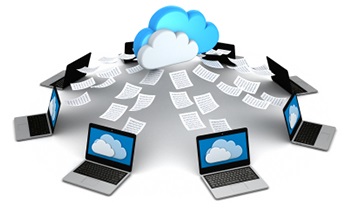How do you know when your data is secure? In business today, almost everyone knows that backups are an absolute necessity, but there are no clear standards that helps you know your data is safe. It seems like there are new appliances and cloud services being created every day that are going to solve all of your problems, but when doing a cost-benefit-analysis, it is hard to know if you are making a good investment.
In the world of data backup, you have desktop backups, server backups, local network attached storage (NAS) devices, cloud backups and backup and data recovery (BDR) solutions. Under each of these categories you have an abundance of products and services that will help provide redundancy. As a rule of thumb, you should have a complete copy of your data in three or more locations.
In a typical network, you will have data being created on desktop computers which are not considered a point of backup. The data is stored on a server which is considered the first point of backup. The server is then backed up to a local appliance like a NAS device. This will give you two independent and complete copies of your data at your physical location. The third backup is usually in the cloud which will give you two or more physical locations where your data is stored. Depending on the specific company needs, you may also have a collocation server and cloud backups for that as well.

Know where your data is being stored!
This is an important aspect of data backup that often goes overlooked. This is typically a problem for end users as they may not understand the difference between saving their data to the server rather than their computers. This problem can be overcome with end user training and the implementation of company policies. Your data is only as safe as your employees’ ability to save it in a secure location. If they save all of their documents to their local computer, all of that information is at risk of being lost should that single computer die.
Why is a NAS important?
You may be tempted to ask. “If I have cloud backups, why do I need a local copy of the data on the server?” The answer is bandwidth. The connection between your server and your NAS device is a lot faster than the connection between your network and your cloud data storage facility. Most backups are set to run every couple of hours and uploading that much data over your internet connection during working hours would make your internet connection almost unusable. Data can easily be backed up to a NAS at several points during the day and from there, the data can be backed up to the cloud after business hours.
A NAS works in the reverse order as well. If by chance you lose a drive on your server and you need to download a large amount of data, it is a lot faster to restore data from a local backup than it is to download it form the cloud. This will decrease downtime should an emergency occur.
Why is the cloud important?
It is equally tempting to ask. “If I have a NAS device, do I really need to back up to the cloud?” The answer is yes. Primarily for reasons of natural disaster. In the event of a fire, flood, earth quake, tornado etc. you stand a good chance of losing all of your data, should your building be destroyed. If this were to happen, it may take some time, but at least you could set your company up in a remote location and your staff would be able to function.
Do I need a BDR solutions?
The answer to this question really comes down to a cost benefit analysis. How much money have you lost over the course of three years due to network downtime? Compare that with the cost of a BDR (Backup and Disaster Recover) device and you will have your answer. In most cases a BDR appliance is a duplicate server that sits at idle waiting for your primary server to stop functioning. If you have had a server outage that has taken up most of a days worth of your employees time then you know that the cost starts to add up quickly. With a BDR appliance, no one would know that your primary server had gone down except for your IT professional.
Monitoring your backups
As if having backups for your backups isn’t enough, you also need to know that your data is being backup up appropriately. There is nothing worse than finding out that after having made the investment to back up your data correctly, your backups haven’t run in the last six months. Backup systems can be finicky and sometimes they run into errors that stop the automated processes. If you don’t know that this has happened you will go about your days thinking that everything is fine. Talk to your IT partner about the status of your data and make sure that they have a system in place to monitor your backups.
By following these simple guidelines and investing the three points of redundancy for your data backup, you can feel confident that you are adequately protected. You will protect yourself from everything from simply deleting files accidentally or having a hardware failure to ransomware and other malicious programs and natural disasters should they ever arise. Consult with your IT professional to make sure that your data is secure and that you have at least three point of redundancy for all of your data.





